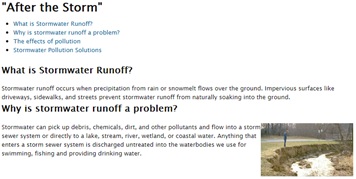While water is an essential component of life, it can also bring destruction. Storms that carry huge amounts of water may cause flooding in low lying areas, and with flooding comes a number of problems that go beyond just soaking your carpets and damaging your drywall.
In particular, pollution is one effect of flooding that has far reaching consequences in all facets of communities. Rainwater by itself is generally clean, but as it sweeps into your community, it gets contaminated by pollutants such as harmful chemicals, garbage, and bacteria. This is when a flood becomes a greater threat to our water systems.
Flooding, however, is not the only cause of pollution on water systems.Simple surface runoff that flows through a community drainage may already bring a significant amount of pollutants to the river or body of water where the drainage system is connected. The United States Environmental Protection Agency (USEPA) elaborates on this in their website.
Stormwater can pick up debris, chemicals, dirt, and other pollutants and flow into a storm sewer system or directly to a lake, stream, river, wetland, or coastal water. Anything that enters a storm sewer system is discharged untreated into the waterbodies we use for swimming, fishing and providing drinking water.
If you have a lawn that slants slightly toward the street, chances are, runoff from a heavy rain may carry chemicals from the fertilizers that you have been using on your grass, to the gutter system, and then to the street pavement. This is one example of how you are contributing to the pollution of the water system, which in turn could be the source of your tap water.
To prevent this vicious pollution cycle, the EPA offers a few simple tips. It is advised that one avoids overwatering the lawn, keeping your yard free of debris and wastes, and using pesticides and fertilizers sparingly.
While these simple steps can be effective in limiting your own contribution to polluting water systems, you can do more.
A residential stormwater system, installed with the help of companies like StormChamber, can catch stormwater that flows through your roof gutters, and direct it through a system of ducts and pipes into a water chamber. These chambers come with a filtration system that separates the pollutants. Thus, you end up with clean water that you can use for such purposes as sprinkling the lawn or cleaning your car.
Effective stormwater systems have been successful in minimizing community flooding which prevents pollutants from entering our water systems. Applied in smaller scales, homeowners like you can contribute to the preservation of the environment as well as the conservation of precious water resources.
(Source: After the Storm, EPA.gov)






